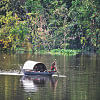Mapping the mangrove forest

Only a few people have both knowledge of and love for the Sundarbans.
Professor Monirul H Khan, author of Sundarbans: The World Heritage (Nymphea Publications, 2021), who has been working on the home of the Bengal tiger for more than two decades, has both—immense knowledge about the mysterious mangrove forest and also love for it.
"The author-cum-photographer of this book has many years of experience working in the Sundarbans region and I consider him as an authority on the Sundarbans", Professor Ainun Nishat, former Vice Chancellor of BRAC University, writes in her foreword for the book.
Professor Khan, a faculty of the Zoology department at Jahangirnagar University, has written the 362-page book using existing data on different aspects of the Sundarbans that are often not easily accessible. He makes use of 262 photographs and 20 artworks, almost all of the photos taken by the author himself. These images are not only beautiful, but are also valuable documentation of rare wildlife species and other forest dwellers, their livelihoods, and important cultural practices of the region.
All aspects of the Sundarbans—from its history to its biodiversity, from the people's professions to their cultures, and even the potential threats to conservation—are covered in the book.
Conversely, it is different from other literature on the Sundarbans that have been published so far, as it covers regions of the Sundarbans in both Bangladesh and India.
Referring to scientific research on fossil pollen, the author informs us that the mangrove species, Sundari (Heritiera Fomes), was a dominant tree genus in Kolkata about five thousands years ago.
The earliest reference to the Sundarbans, according to Professor Khan, can be traced back to the epic Mahabharata (around 300 BC to 300 AD), in which the eldest and second Pandava brothers, Yudhishthira and Bhima, visited Gangasgar (literary meaning "place where river Ganges met the sea") during their pilgrimage.
Even today, thousands of Hindu pilgrims visit Sagor island in the Indian Sundarbans and Dubla Island in the Bangladesh Sundarbans. Through his discussion of these rituals, the author shows how the culture, myths, and beliefs of the people of this region are evolving, centering the Sundarbans, from a very ancient time.
The British East India Company took control over this region (including the Sundarbans) in 1757. By 1770, they started to convert the forest lands of the Sundarbans to agricultural land and started commercial logging. Some two hundred years ago, the Sundarbans comprised double than its current area, around 10,000 square km of which 60 percent lies in Bangladesh. As the book's appendix reveals, 76 mangrove plants, 44 mammals, 374 birds, 68 reptiles, 16 amphibians, 380 fish and 82 crustaceans are to be found in these forests. The land and ecosystem serve as a natural barrier against cyclones and save millions of lives and agricultural fields in the north.
Apart from these discussions on how the forest came into existence and how it has survived destructive human practices, the book narrates valuable details, one of which are conservation efforts to save the big cats.
In the chapter titled "Iconic Tiger", Professor Khan states, "Out of fear and respect, the local people call it 'mama', which literally means 'maternal uncle'". "There were [...] tigers in 11 districts out of 17 of the British Bengal till 1930", the author writes. This large predator was so abundant and widespread that it was treated as a menace, and the government used to pay bounty for killing tigers.
Citing Banglar Shikar Prani by Satish Mitra, the author mentions Pachabdi Gazi, the last remaining hunter from the traditional hunter family from the Sundarbans region, who killed the last tigers on January 20, 1987. Gazi killed 57 tigers in his lifetime. Currently, the entire Sundarbans holds only around 210 tigers—the national animal of both India and Bangladesh.
"The book is a significant addition to our campaign for 'Promoting Bangladesh' and an exploration of the Sundarbans through the lens of ecological diversity, culture, and livelihoods", Karunangshu Barua writes in his publisher's note for the book.
The book is available at the stall of Nymphea Publications at the Ekushey Boi Mela.
Pinaki Roy is Chief Reporter, The Daily Star. Collage: Orchid Chakma

 For all latest news, follow The Daily Star's Google News channel.
For all latest news, follow The Daily Star's Google News channel. 







Comments